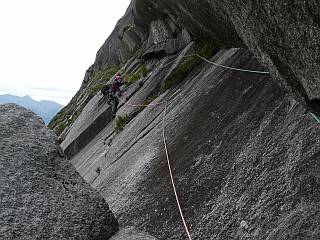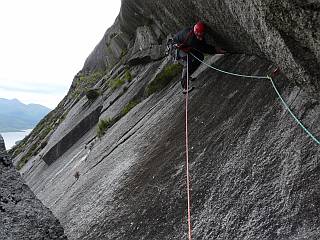My first acquaintance with The Pause on the Etive Slabs came in July 1990, when I seconded Scott Davidson up the first three pitches before declining the lead when he failed to find his way up the fourth, and we hastily abseiled off to escape the midges after traversing onto Spartan Slab (scene of my first big VS lead two months previously) with the intention of finishing up that.
It’s a sustained and exciting route, first climbed in 1960 by the kenspeckle quartet of the Marshall brothers, Ritchie and Tiso with four (?) points of aid and a tension traverse, but still impressively bold considering the footwear and hardware available to climbers of that era. Now going completely free, it’s given (depending on the age of your guidebook?) either HVS or E1, with the lower grade appearing in the older guides (1980 SMT Glencoe and Glen Etive, 1990 Howett Rock Climbing in Scotland) and the higher grade the apparent consensus of more recent sources (2002 SMC Glencoe, Glen Etive and Ardgour, 2008 Latter Scottish Rock, UKClimbing Logbook). Apparently named for the ‘pause’ while the first ascentionists puzzled over where to go on the pitch that spelled the end of our 1990 attempt, it continued to haunt me over many subsequent years when I did little climbing, until 2008 saw me starting to climb seriously again and 7 September (the day after my fifth Ben Nevis Race!) saw Magnus Johnson and me setting off up the boggy approach path with intent...


Now, I cunningly chose to lead the first pitch so I’d get the 5b (technical) crux traverse into the ‘Crevasse’ of the third and Magnus would get that scarier and less obvious fourth but, after a single look at the slab above the commodious stance convinced him to give it straight back to me and I couldn’t reconcile myself to traversing onto Spartan again, I actually ending up leading 1, 3, 4 and 6 while he led 2, 5 and 7. But I digress, and should start the account of the climb from the beginning...
We arrived at the Coffin Stone (which, despite its alarming name and occasional role as target practice for clumsy climbers trundling boulders from the descent path hundreds of feet above, is a delightful picnic/gearing-up spot at the foot of the crag) on a perfect September day with sunshine, a gentle breeze and no midges. There was a pair just starting The Long Reach (highly-regarded E1/E2, and very sustained at pitch after pitch of 5b where most of The Pause gets 5a) and another arrived a bit later to do Hammer (at HVS the next easiest line to Spartan, and the only other on the crag I’d previously done), but otherwise we had the whole place to ourselves. The omens might or might not have been good when (after Magnus arrived clutching my van keys which he’d luckily retrieved from that overgrown, boggy path and I realised that the jam doughnuts were still in the van) I had to beat a prompt retreat when the wrong groove petered out into unprotected thin-ness and then dropped two Wallnuts down the right groove! But things rapidly settled after that inauspicious start, I felt I made quite a neat lead of the first pitch in the end (avoiding one damp patch in its upper groove by splitting the footwork between some small ledges on its left wall and the drier slab further right) and Magnus led through to the very pleasant layback flake of the second.
And so to the 5b traverse, where smearing feet and tiny underclings for the hands basically take you rightwards below a big roof (the famous overlap crossed at its highest point by the E7 Angel and elsewhere by Swastika, The Long Reach, Spartan Slab and others) to the security of the Crevasse, which is a kind of slot/ledge through it. While there appears to be more than one way to get established on this traverse, I chose to head high sooner rather than later to avoid another damp patch (virtually the only other we found), placed most of my small cams too early, fiddled a poor micro nut to protect the start of the traverse proper and had made all the thinnest moves (barely room for your finger tips in some of those ‘underclings’!) before slipping and swinging onto said micro nut just as I reached comparitive security where the crack widened sufficiently to take both fingers and a slightly larger cam (1.5 Friend?). Now, since leader falls from this traverse tend to take you away from your destination (but seconding falls towards it!), I had to get back up there and do the whole thing again, but found a decent crack for a bigger wire on my way back up and this time completed the thin bit clean, placed the cam and continued right more comfortably before finally half leaning, half jumping into the Crevasse. And here we took quite a Pause (not quite the 18 Year Pause since my previous visit, but still quite some time and doubtless longer than the first ascentionists!) while we deliberated what to do and I managed to get myself sufficiently psyched up to get established on the slab above.
Like Spartan Slab with its alleged crux overlap (one isolated brute of a move!) followed by a delightfully intricate and delicate fourth pitch, I’d say the fourth pitch of The Pause is in some ways its ‘true’ crux. While the Pause traverse is obviously much more delicate than the Spartan overlap, the following pitch is less obvious, more run-out as it crosses the odd blank patch between more secure holds and cracks, and quite simply more scary! (NB I’ve also seen it graded at everything from 4c in the 2002 SMC Glencoe guide to 5b in the 2001 revision of Howett’s Scottish volume and can only offer E1 5a as my best guess.) So I’m calling Magnus to ‘watch me like ****’ (as if it would make any difference!) as I’m padding towards the next piece of bomber protection across a holdless slab some twenty feet above and to the right of my last runner, and Magnus has a similar scary moment on a similar padding slab early on the fifth pitch as he leads through. But the upper part of that fifth pitch turned out to be a romp and, after a tricky start up the right-hand end of the upper overlap, the sixth (which I led) finishes up a delightful layback which I was happy to take in a single run-out where you could place runners pretty well anywhere if you wanted/needed to. And here you spill out onto a gigantic grassy ‘ledge’, where The Pause properly finishes up a short vertical corner (shared with many of the other routes) some way to the left. But, since we were running short of daylight (the Long Reach pair had reached the foot of the crag as we tackled our fifth or sixth pitch and we could hear the Hammer pair on the descent path above), we chose to top out via a short cracked wall directly above our stance (let’s call that a logical variation finish!), made the Coffin Stone in reasonable light and finally reached the van and the jam doughnuts in near dark.
So here ends the tale of my ‘18 Year’ Pause. It took a long time to finish the route, and some might argue that it remains unfinished, but we completed all the main slab pitches and that short detached corner can keep for the next time I do Spartan (which will be my third) or almost anything else on the Slabs. Some might also argue that the route remains HVS, but (as cited above) the recent consensus appears to be E1 and I’m claiming E1! And (while I’m not naive enough to think that one route of the kind of delicate, balancy climbing I particularly enjoy instantly makes me an ‘E1 leader’), it’s still a true milestone on my return to climbing and in my continued development and renewed self-respect as a climber (on which note, I think Magnus both enjoyed it as much as I did and took something similar out of the experience!). :-)
Feedback to webmaster@petestack.com